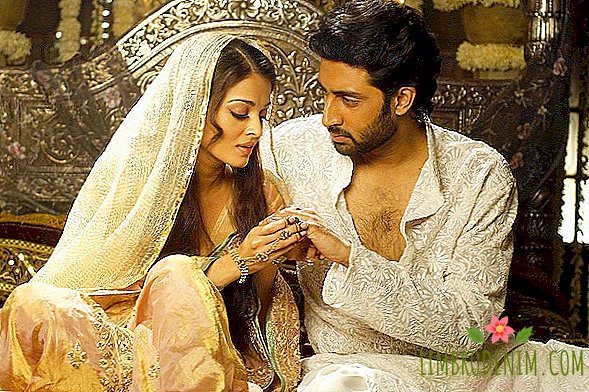From Bollywood to Violence: How Women Live in India
ABOUT LIFE OF INDIAN WOMEN we learn either from Bollywood classics like "Zita and Gita", or from news reports: while cheerful beauties sing bright sarees on the screen, in the real world women are doused with sulfuric acid and mutilated during sterilization operations. Recently, social networks circled an art project in which the position of women is compared with cows - not in favor of the former.
In Indian culture, a woman is still assigned only two roles: depending on her age, she is perceived either as a continuation of a man (daughter or wife), or as the mother of a family — the keeper of the hearth. Both in the first and in the second case, the woman has no real voice, that is, her life is completely dependent on the will of the man. In the past few years, the country has openly started talking about domestic and sexual abuse, about contractual marriages, and even about monthly ones. We asked Victoria Krundysheva, who moved to India five years ago, to tell about the origins of cruel practices and what is happening with Indian women today.

Self-immolation and the legend of Sati
Hindu mythology is metaphorical and open to interpretations — there are many strong and independent female images in it, but the patriarchal structure allows only one interpretation of mythological plots. The ideal wife and role model for Indian girls was Sati (Savitri) - the heroine of the ancient epic "Mahabharata". Savitri's main quality is her endless love for her husband: according to legend, the princess followed the loved ones to the other world after his death and, thanks to her cunning and sharpness, defeated the local ruler, rescuing both her husband and herself. Over time, Savitri's story transformed: in later retellings of myth, the wisdom of the princess no longer comes to the fore, but the fact that her loyalty and worship to her husband forced her to follow him to the afterlife. The name “sati” has received a cruel tradition that obliges a widow after her husband's death to ascend to the funeral pyre and burn alive with the body of her husband - to meet with him the afterlife.
Refusing to voluntarily say goodbye to life was considered a disgrace. Women who did not want to burn with their dead husband were not respected and avoided, and more often punished - that is, they were burned anyway. The sati rite that was spread throughout the subcontinent is a vivid illustration of the position of women in Indian society: the first evidence of this practice dates back to the 1st century BC, and it received its greatest popularity in the 1800s. Although over time, the Sati rituals were performed less and less often — they only persisted in distant villages and the poorest regions of India — the tradition was finally eradicated only after the Prevention of Sati Act in 1987, which was adopted after a loud case of self-immolation 18 -year widow.
Dauri and femicide
Femicide (female infanticide, or the killing of newborn girls) in India has been practiced for centuries and continues to exist today. True, the killing of babies is coming to naught, as the opportunity to do selective abortions has appeared. There are many reasons for the appearance of femicide: it is general poverty, and the need for hard physical labor, which men are mainly engaged in, and the duty of the bride's parents to pay the family’s son-in-law a rich dowry. And although, like sati, femicide was banned during the British rule, for a long time it remained one of the main social problems of India.
In 1991, the government adopted the “Program for the Protection of Children”, and a year later the “Lullaby Program” allowing anonymous adoption of children. In some states, families with two or more daughters are paid benefits. Despite government measures, femicide significantly influenced the demographics in the country: today in India there are 100 girls for 110 boys born. To stop selective abortions, the state has banned procedures for determining the sex of the child - however, in underground clinics, it can still be done for 3-8 thousand rupees (approximately the same amount in rubles). Only in 2016, twelve doctors were suspended from work on suspicion that they violated the ban. In the fight against femicide, the government and non-profit organizations have engaged social networks and marketing campaigns, their most famous slogan is "Save a Girl Child" ("Save the Girl").
The ancient custom of dauri - the so-called tradition that obliges the family of the bride to pay the groom's family - is another illustration of the fact that a woman in the Indian way is considered a burden. You can pay with money and "gifts": real estate, cars, decorations and expensive household appliances. Dauri was officially banned in 1961, but it is difficult to track the payment of a dowry, so the practice still exists.
The dauri system supports the idea that men are more valuable than women and have innate privileges. She permeates the entire matrimonial system of India - this is especially noticeable when searching for a bride, when absurd demands are made on a woman: education, talents, skin color and appearance of a potential spouse are estimated. The best bride is the one that promises not to work after the wedding, but to engage exclusively in housekeeping and children.

Bollywood and stereotypes
Bollywood completely possesses the minds and hearts of Indians of all ages - therefore, the gender stereotypes that it translates deserve special attention. Until recently, female images in Bollywood were represented either by heroines, always secondary to the main character, or by participants in the so-called item numbers (musical inserts). The heroine item number is a seductive beauty who appears in the film for one song and does not add anything new to the story, but simply pleases the man’s eye. The Bollywood dichotomy of the “female angel” - “whore woman” greatly influenced the worldview of the Indians: society sticks the label “bad” or “good” to a woman in accordance with the film standard.
The degree of objectification of women in Indian cinema is difficult to understand without understanding the lyrics: the compositions accompanying the item numbers often have unequivocal sexual overtones and openly encourage violence. “It doesn’t matter if you say yes or no. You are mine, Kiran,” everyone in India knows this line from a famous song by heart. It sounds from the mouth of the cult actor Shahrukh Khan. Rapper Hani Singh, whose tracks are often heard in Bollywood blockbusters, is constantly accused of misogyny. The singer does not hide his attitude towards women: he recorded a whole album about sexual abuse, which is called “Rapist”.
Men sing these songs on the street when any girl seems attractive to them. Largely due to Bollywood, street harassment is considered the norm. In the popular comedies, for example, "Breaking Out in Full - 2" ("Grand Masti"), the main characters stick to the heroine on the street and follow her until she gets tired of attention and does not "give up." From such scenes, viewers learn that a woman who is disinterested or openly rejecting a boyfriend is not a stop sign, but a challenge and a sign that it is necessary to molest more actively, to “get” girls.
Recently, an encouraging trend can be traced in Indian cinema: more and more strong heroines and protagonist women appear in films (for example, in the films "Queen", "History" ("Kahaani") and "Mary Com"). However, mass cinema is still kept on "testosterone" comedies and blockbusters, bringing a large income.
Nirbaya and the land of violence
The turning point in the discussion of women's rights happened in December 2012, when the whole country learned about the horrific gang rape in Delhi. The city is called the "capital of rape" - this is where the most brutal crimes against women take place.
On December 14, a 23-year-old girl (in the press, her name was not disclosed, giving her the pseudonym Nirbaya) went to the cinema with her young man. After the session, they boarded a bus, where there were six men, including one minor; they brutally beat the girl and raped her, and then left her naked and bleeding on the road. A young man who tried to protect Nirbayu was hit on the head, but survived, and his companion died in hospital two weeks later due to numerous injuries of internal organs. The crime received unprecedented publicity and caused a strong reaction in India and in the world. Protests were held in Delhi and other cities, and rapists were arrested and sentenced to death after a long trial.
The death of Nirbay provoked a serious discussion about the situation of women in India, but the problem remains unresolved. Politicians talk a lot about the fact that it would be nice to ensure the safety of women and toughen punishments for rape, but crimes are not getting less, and many of them are brutal. In the Indian capital Delhi, women try not to go out alone after dark.
It is worth noting that women of Indian origin are primarily victims of violence and discrimination, and foreign women, even if they live in the country for a very long time, feel more secure. Perhaps this is due to the fact that crimes against foreigners attract the attention of state services and consulates, and the police take them more seriously so as not to incite an international scandal. Foreign women, especially from Europe, are considered more "dissolved" and - if we use Bollywood terminology - more than "item", that is, performing a decorative and entertaining function.

Victory labeling and Western values
After the Nirbayi case and other high-profile crimes, the Indians began to openly demand the reaction of the authorities. But the majority of political and religious leaders not only refuse to take responsibility for solving the problem, but add fuel to the fire, blaming the victims of violence and openly supporting the patriarchal attitudes.
Mass protests in 2012, one of the country's largest religious leaders, Asaram Bapu, commented: “The victim is guilty not less than rapists. She shouldn’t resist, but appeal to rapists as brothers and beg them to stop. She shouldn’t get on the bus and go to a movie with a young man. " "Women should not hang around the streets with men if they are not related to them. Such cases are the result of the influence of Western culture and style in dress," said the leader of the right-wing political party Rashtriya Svayamyavak Sangh Mohan Bhaguot. Putting blame on the "influence of the West" is a characteristic trick for politicians who advocate "preserving traditional Indian culture." This apparently populist attitude ignores the fact that many women from traditional families who have no access to Western culture are being abused.
To the demands of capital punishment for rapists, politician Moulayam Singh Yadav said: "Boys behave like boys, do you really have to hang them for it?" The progressive sections of Indian society are horrified by such statements, but most of the population falls under the influence of populists. In the mass, Indians still believe that the victim is “guilty”, and in some cases violence can be justified.
Women who survived violence rarely go to the police: because of corruption, many cases do not go to court, and besides, victims are often mistreated. Police admit malicious comments and openly humiliate women, and there are cases of violence in police stations. Human rights activists believe that in 9 out of 10 cases of rape, the victim does not report him to the authorities, which is why criminals feel absolute impunity and permissiveness.
Talk about equality
In India, there is still no law prohibiting domestic violence. Women face harassment in public transport every day, obscene comments on the street and condemning glances from older people who do not like their “too modern” or “too open” clothes. However, there are shifts for the better: in the past few years, violence has finally begun to be talked about, and popular media and celebrities have realized how much they influence society — and now they are openly calling for respect for women.
More and more media and social platforms are writing about equality - and for the first time in many years they are calling to actively fight against sexism and oppose violence. Bollywood reacts to the changes: the sensation of 2016 was the film "Pink" ("Pink") with one of the country's most famous and respected actors, Amitabh Bachchan. This film touches on the problem of victim labeling, talks about the principle of consent and respect for the rights of women.
Modern India is just beginning to talk about feminism. As in any entrenched patriarchal system, the ideas of equality are met with resistance. Already, it can be noted that millenial girls are more independent than their older sisters and mothers, and are ready to stand up for themselves - but emancipation will obviously take many years.
Photo: Wikimedia Commons, Reliance Entertainment, Getty Images (1)





